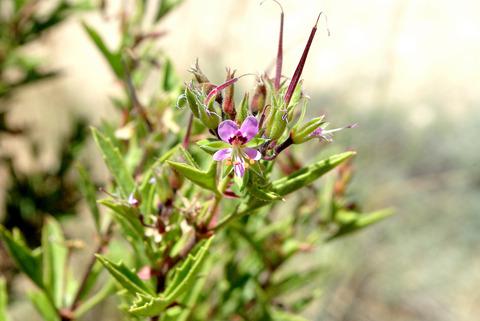当前位置:
X-MOL 学术
›
Funct. Ecol.
›
论文详情
Our official English website, www.x-mol.net, welcomes your
feedback! (Note: you will need to create a separate account there.)
Impact of rainfall seasonality on intraspecific trait variation in a shrub from a Mediterranean climate
Functional Ecology ( IF 4.6 ) Pub Date : 2020-04-01 , DOI: 10.1111/1365-2435.13533 Timothy E. Moore 1 , Cynthia S. Jones 1 , Caroline Chong 2 , Carl D. Schlichting 1
Functional Ecology ( IF 4.6 ) Pub Date : 2020-04-01 , DOI: 10.1111/1365-2435.13533 Timothy E. Moore 1 , Cynthia S. Jones 1 , Caroline Chong 2 , Carl D. Schlichting 1
Affiliation

|
Selection pressures along climate gradients give rise to predictable variation in plant functional traits of individual species suggestive of local adaptation. Species whose ranges include winter rainfall, Mediterranean climates, or other strongly seasonal climates, may be exposed to divergent selection pressures at different ends of seasonality gradients. Here, we evaluate how rainfall seasonality in conjunction with other key climatic variables impacts patterns of trait variation in Pelargonium scabrum, a woody shrub from the Greater Cape Floristic Region of South Africa. This biodiversity hotspot encompasses a Mediterranean climate (wet winters and hot, dry summers) and displays steep gradients in temperature and water availability. We used Bayesian regression models to evaluate leaf trait–trait and trait–climate relationships among 26 populations. Models included rainfall seasonality and its interaction with other climate variables (mean annual temperature, mean annual precipitation and potential evapotranspiration) as predictors to test for the impact of climate variation on three leaf traits: size, dissection and leaf mass per area (LMA). We evaluated model explanatory power by calculating Bayesian R² values, and predictive power via leave‐one‐out cross‐validation. Trait–trait associations were modulated by rainfall seasonality, including a reversal in the relationship between leaf size and dissection depending on the proportion of rain received in winter. Trait–climate models were improved by including rainfall seasonality as a predictor for both explanatory and predictive power. For leaf dissection and LMA, we detected significant interactions between rainfall seasonality and other environmental variables, leading to reversals in the relationships between these traits and the three environmental variables depending on the proportion of winter rainfall. Differences in the timing of rainfall, coupled with strong differences in the covariation of climate variables, impose divergent selection pressures on P. scabrum populations resulting in divergence of trait values, trait integration and responses to climate gradients. These patterns are consistent with local adaptation of P. scabrum populations mediated by the interactions between temperature and the amount and timing of rainfall. Species arrayed along broad climate gradients represent an excellent opportunity for investigating patterns of trait variation and abundances and distributions of species in relation to future changes in climate. A free Plain Language Summary can be found within the Supporting Information of this article.
中文翻译:

降雨季节性对地中海气候灌木种内性状变异的影响
沿着气候梯度的选择压力会导致个别物种的植物功能性状发生可预测的变化,表明当地的适应能力。范围包括冬季降雨、地中海气候或其他强烈季节性气候的物种可能会在季节性梯度的不同端面临不同的选择压力。在这里,我们评估降雨季节性与其他关键气候变量如何影响天竺葵(一种来自南非大开普省植物区的木本灌木)的性状变异模式。这个生物多样性热点包括地中海气候(潮湿的冬季和炎热干燥的夏季),并显示出温度和可用水量的陡峭梯度。我们使用贝叶斯回归模型来评估 26 个种群之间的叶子性状 - 性状和性状 - 气候关系。模型包括降雨季节性及其与其他气候变量(年平均气温、年平均降水量和潜在蒸散量)的相互作用,作为预测气候变化对三个叶片性状的影响的预测因子:大小、解剖和单位面积叶片质量 (LMA)。我们通过计算贝叶斯 R² 值来评估模型的解释能力,并通过留一法交叉验证来评估模型的预测能力。性状-性状关联受降雨季节性调节,包括根据冬季降雨的比例,叶片大小和解剖之间的关系发生逆转。通过将降雨季节性作为解释力和预测力的预测因子,特性-气候模型得到了改进。对于叶解剖和 LMA,我们检测到降雨季节性与其他环境变量之间的显着相互作用,导致这些性状与三个环境变量之间的关系根据冬季降雨的比例发生逆转。降雨时间的差异,加上气候变量协变的强烈差异,对 P. scabrum 种群施加了不同的选择压力,导致性状值、性状整合和对气候梯度的响应的差异。这些模式与由温度与降雨量和降雨时间之间的相互作用介导的 P. scabrum 种群的局部适应是一致的。沿着宽阔的气候梯度排列的物种代表了一个极好的机会来研究与未来气候变化相关的性状变异模式以及物种的丰度和分布。可以在本文的支持信息中找到免费的普通语言摘要。
更新日期:2020-04-01
中文翻译:

降雨季节性对地中海气候灌木种内性状变异的影响
沿着气候梯度的选择压力会导致个别物种的植物功能性状发生可预测的变化,表明当地的适应能力。范围包括冬季降雨、地中海气候或其他强烈季节性气候的物种可能会在季节性梯度的不同端面临不同的选择压力。在这里,我们评估降雨季节性与其他关键气候变量如何影响天竺葵(一种来自南非大开普省植物区的木本灌木)的性状变异模式。这个生物多样性热点包括地中海气候(潮湿的冬季和炎热干燥的夏季),并显示出温度和可用水量的陡峭梯度。我们使用贝叶斯回归模型来评估 26 个种群之间的叶子性状 - 性状和性状 - 气候关系。模型包括降雨季节性及其与其他气候变量(年平均气温、年平均降水量和潜在蒸散量)的相互作用,作为预测气候变化对三个叶片性状的影响的预测因子:大小、解剖和单位面积叶片质量 (LMA)。我们通过计算贝叶斯 R² 值来评估模型的解释能力,并通过留一法交叉验证来评估模型的预测能力。性状-性状关联受降雨季节性调节,包括根据冬季降雨的比例,叶片大小和解剖之间的关系发生逆转。通过将降雨季节性作为解释力和预测力的预测因子,特性-气候模型得到了改进。对于叶解剖和 LMA,我们检测到降雨季节性与其他环境变量之间的显着相互作用,导致这些性状与三个环境变量之间的关系根据冬季降雨的比例发生逆转。降雨时间的差异,加上气候变量协变的强烈差异,对 P. scabrum 种群施加了不同的选择压力,导致性状值、性状整合和对气候梯度的响应的差异。这些模式与由温度与降雨量和降雨时间之间的相互作用介导的 P. scabrum 种群的局部适应是一致的。沿着宽阔的气候梯度排列的物种代表了一个极好的机会来研究与未来气候变化相关的性状变异模式以及物种的丰度和分布。可以在本文的支持信息中找到免费的普通语言摘要。











































 京公网安备 11010802027423号
京公网安备 11010802027423号